Hush E2-MCE – Silent Media Center PC Review
Hush E2-MCE – Silent Media Center PC
If you're looking for a Media Center PC that looks amazing and is completely silent, Hush Technologies has the answer.
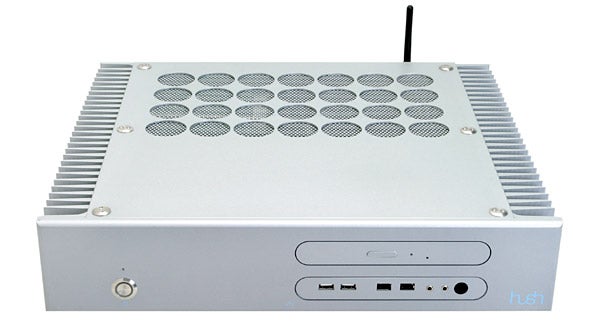
Verdict
Key Specifications
- Review Price: £1791.00
There are two critical requirements for a Media PC that’s going to reside in your living room, it has to look great and be quiet as a mouse. Unfortunately, these two requirements are poles apart when it comes to designing and engineering a computer. In order to make a PC look good it needs to resemble a consumer electronics device with slim dimensions like a modern DVD player, but the slimmer and more attractive you make a PC, the hotter it becomes inside and the more fans you have to use to cool it, resulting in greater noise pollution. Tackling the problem from the other side, you can use a large case with lots of air flow, along with large fans spinning at low speed and making very little noise, but the result is a big, ugly system that no one would want in their living room.
However, German custom PC builder Hush Technologies has managed to create machines that fulfill both criteria with aplomb. Hush PCs, as the name suggests, are completely quiet in operation. This is due to the fact that there isn’t a single fan spinning inside the system case – absolutely everything from the CPU to the graphics card is passively cooled. Now Hush has been building fanless ATX systems for some time and I reviewed one myself here, but this is the first time that Hush has taken its passively cooled PC design to its natural progression and equipped it with Microsoft Windows XP Media Center Edition.
This is the first Media Center PC ever to roll off the Hush production line, and I have to say that if this is Hush’s idea of a first attempt, it’s not leaving itself much room for improvement. Usually when I’m looking at an early sample of a new product, I find it to be a little rough around the edges, but everything on this Hush is as close to perfect as it’s ever going to be. Of course from a hardware perspective this isn’t surprising, but I thought that there might be a few software niggles, since Hush has never implemented Media Center before, but running MCE proved to be as smooth as the beautifully machined Hush casing.
Hush Technologies has definitely taken PC build quality to a new level with it’s custom machined case. The front fascia is machined from a single billet of aluminium that’s over a centimetre thick, but it’s the side panels that are really impressive. Hush must have started with solid billets of aluminium of almost five and a half centimetres thick to create the side panels. Those solid blocks of aluminium have then been machined into vertical fins, then each one of the fins has again been machined with ridges for ultimate heat dissipation. About 15mm of the side panel has been left solid, in order to soak up all the heat, that is then radiated out through the fins.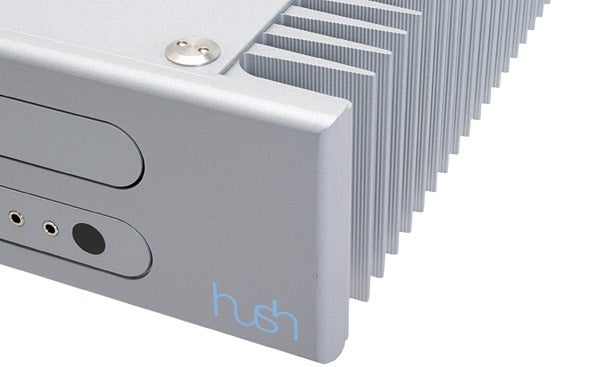
The reason that you need the fins at the side to dissipate the heat, is that Hush uses passive heatsink and heatpipe technology to cool the system. The 2.8GHz Pentium 4 processor is capped by a low-profile passive heatsink with a large heatpipe running through the centre of it. This heatpipe is then routed to the right hand side panel, where it runs for about 150mm to ensure as much surface contact as possible. The motherboard chipset is also topped with a passive heatsink, complete with heatpipe as well, but this one is routed to the left hand side panel. The ATI Radeon 9600 graphics card is also cooled passively with a heatsink and heatpipe assembly – this is also routed to the left hand side panel for heat dissipation.
Talking of the graphics card, it’s mounted horizontally along with the TV Tuner card to ensure that the height of the PC is kept as low as possible. Hush has used a single riser card that plugs into both the AGP slot and a PCI slot, allowing an AGP card and a single PCI card to be used in the system. This configuration does limit the amount of PCI cards you can use, but it’s an acceptable compromise to achieve a décor friendly form factor. It’s also worth remembering that there is so much functionality integrated into modern motherboards these days, that the need for more than one PCI card is shrinking. 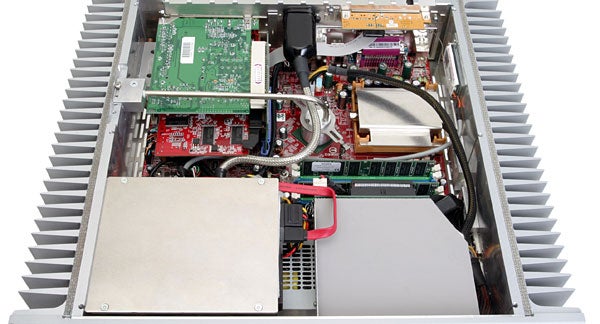
Now, if you’ve read any of my other media PC reviews, you’ll know that I believe that wireless networking is a vitally important feature in a machine like this, so is the single PCI slot too much of a compromise to satisfy my media PC requirements? Thankfully the answer to that question is a resounding no, since those guys at Hush are a pretty clever bunch and have ensured that the E2-MCE has integrated WiFi functionality. Hush has wisely invested in the WiFi adapters that Shuttle uses in its small form factor boxes – not only are these adapters tiny, but they also connect to a USB 2.0 header on the motherboard, so there’s no need for a spare PCI slot. There’s a screw in antenna that attaches at the back, that enabled the E2-MCE to connect up to my WiFi access point without any problems.
The FIC motherboard has four DIMM sockets, two of which are filled with 256MB 400MHz DDR modules for a total of 512MB of system memory. You could boost the memory up to 2.5GB if you went for 1GB modules, but really a PC like this doesn’t need masses of memory. The hard disk is a 200GB SATA model which should keep you happy for a while, although Hush does offer hard drive options up to 400GB for the truly storage hungry. The hard disk is mounted in an acoustic casing to keep the noise down, and this is mounted against the left hand side panel to ensure that the heat generated by the hard disk is efficiently dissipated. 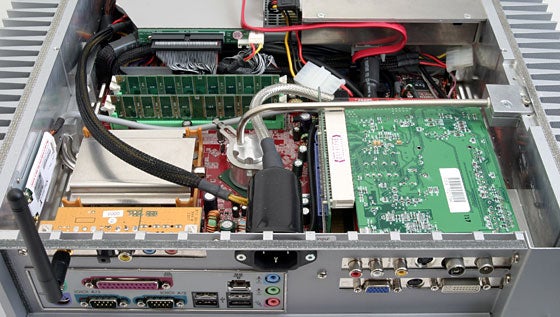
Below the hard disk is the power supply, which is also mounted against the side panel to allow the heat to flow away and out of the machine. Because the PSU is mounted at the front of the case instead of the rear, there is a power cable that runs through the case to a socket that’s mounted in the centre of the rear backing panel. There was some concern from one of my colleagues that this would cause interference with other components in the PC, but there wasn’t any evidence of this whatsoever.
Hush has used a notebook optical drive to save space, but that doesn’t mean that functionality has been limited. The optical solution is a DVD writer that will burn to both DVD+R/RW and DVD-R/RW standards, making it an ideal partner for MCE, which allows you to export recorded content to DVD. 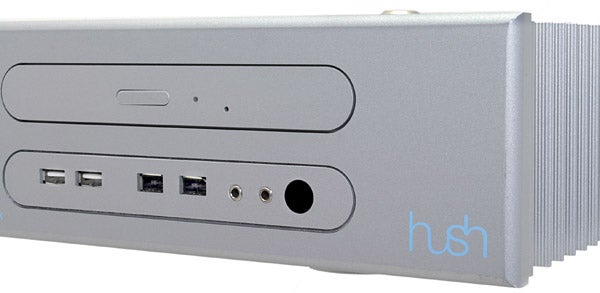
The front fascia of the Hush E2-MCE looks superb, in a kind of Tag-Mclaren minimalist/industrial HiFi component kind of way. On the left is a single, round power button that’s circled in blue light (what else?) when the unit is powered on. The right hand side is dominated by the optical drive and the front mounted ports. The optical drive tray is long, with rounded edges – there’s a single eject button, an activity light and a manual eject hole. Below this is a row of ports, mounted on a long, rounded fascia that matches the optical drive. Here you’ll find two USB 2.0 ports, two six-pin FireWire ports, headphone and speakers jacks, and the IR receiver for the Media Center remote control. Basically, from the front the Hush E2-MCE looks like a very expensive piece of HiFi or home cinema equipment, which, to be honest, is exactly what it is.
At the rear there’s a full array of PC ports, along with some welcome additions. On the main motherboard port cluster you’ll find two PS/2 ports, two serial ports, a parallel port, four USB 2.0 ports, a network socket, line-in, line-out and microphone ports. Above this there’s an expansion card with both optical and coaxial S/PDIF ports, and two more audio outputs for 5.1-channel analogue sound output. The wireless antenna connection is also mounted here.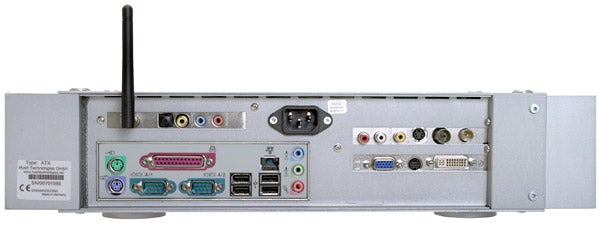
The other connections are on the expansion cards. The 128MB Radeon 9600 graphics card has both DVI and D-SUB connectors, as well as an S-Video output, while the TV tuner is very well featured. The E2-MCE came supplied with an analogue TV tuner, but you can specify a digital tuner at no extra cost – on the TV tuner card is an aerial input for TV, another aerial input for FM radio, S-Video input, composite video input, and left and right audio inputs.
So, the Hush E2-MCE is a beautifully constructed PC that would put some high-end audio manufacturers to shame, let alone PC builders, but what’s it like to use? Well since the E2-MCE is running Windows Media Center Edition 2005, it comes as no surprise that the user interface is slick and easy to navigate. Although there are many third party media environments that you can use to build a media PC, nothing feels as integrated or smooth as MCE. The Hush E2-MCE was an absolute joy to use, switching between all the Media Center functions quickly and easily, and never once did the machine hang or crash. It just felt completely natural controlling a machine that looks like the Hush with a remote control rather than a keyboard and mouse.
The TV tuner is obviously a good one, because even in the poor reception area of Bracknell, I managed to get a decent quality image on most channels. If I have one criticism of this machine, and it really is just the one, it’s that it doesn’t have dual TV tuners. Now I know that there’s only one spare PCI slot, but you can get dual tuners on a single PCI card, but Hush doesn’t even offer this as an option on its website. This means that you can’t record one channel while you’re watching another. To be fair, dual tuner cards are still pretty new, so I’m hoping that Hush will add one to its option list in the future. 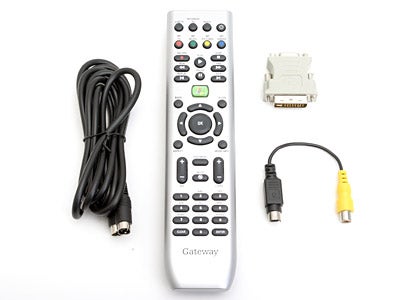
The integrated WiFi makes downloading electronic programme guides easy, while also making use of MCE 2005’s Online Spolight services is also simple as pie. The latter is a list of online services that are tailored for a remote control navigation environment. The services are a little limited at the moment and many of the music and movie download services require registration and payment. However, Music Brigade is definitely worth a look – this is a free service that lets you stream music videos to your Media Center PC. The quality of the video isn’t amazing, but the amount of choice definitely is.
But don’t go thinking that the only software you’re going to get is Media Center, because Hush has also bundled Microsoft Works Suite 2005. This is a great little office suite, since it includes a full version of Microsoft Word, which is the application that most people need anyway. There’s also a copy of Cyberlink PowerDVD in case you want to watch DVD movies under Windows instead of from within Media Center, and a copy of Nero for those CD and DVD burning duties. Finally eTrust Antivirus is pre-installed to keep you safe.
Although the E2-MCE has S-Video output, that’s not really the way a machine like this is likely to be connected. This is the type of machine that’s going to be part of a high-end AV setup, so it will probably be connected via DVI to a progressive scan flat screen or projector. It’s only with this kind of display that you can show off Media Center to its best, especially if you plan on watching High-Definition WMV content.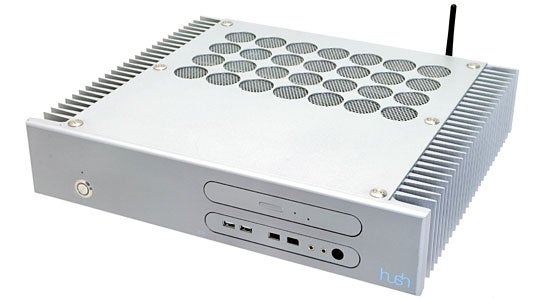
I have to say that I like Media Center – it represents a big step in the right direction as far as convergence goes. So, coupling Media Center with a Hush ATX PC – arguably the most beautifully built PCs that money can buy – is bound to be a winning combination. But of course there’s always that old saying that you get what you pay for, nagging at the back of my mind and unsurprisingly, you’re going to have to dig deep for a Hush Media Center PC. The E2-MCE in the review configuration will set you back £1,791.38, which is not an insignificant amount of money by anyone’s standards. You also have to consider that you don’t get a monitor, or even a keyboard and mouse.
So, do I think that the Hush E2-MCE is worth the money? Well, if I was going to buy a Media Center PC to sit amongst my home cinema equipment, this is the one that I’d want. Not only does it perform flawlessly, but it looks like a work of art that wouldn’t be out of place in the recently refurbished Museum of Modern Art in New York. Yes the price is very high, but a lot of that cost is going into the superb construction of the machine itself and all the attention to detail therein.
The Elonex Lumina may be the best all-in-one Media Center solution out there, but if you’re looking for something to sit on your HiFi or home cinema rack, the Hush will blend in beautifully with your power and pre-amp setup.
”’Verdict”’
If you’re a serious home cinema buff and you’re looking to add a Media Center PC to your system, the Hush E2-MCE is exactly what you’re looking for. This is the most beautifully constructed Media Center PC that I’ve ever seen, and it would complement even the most high-end AV setup. There’s no denying that it’s expensive, but if you want the best, you’re going to have to pay for it.
Trusted Score
Score in detail
-
Value 7
-
Features 10
-
Performance 9

